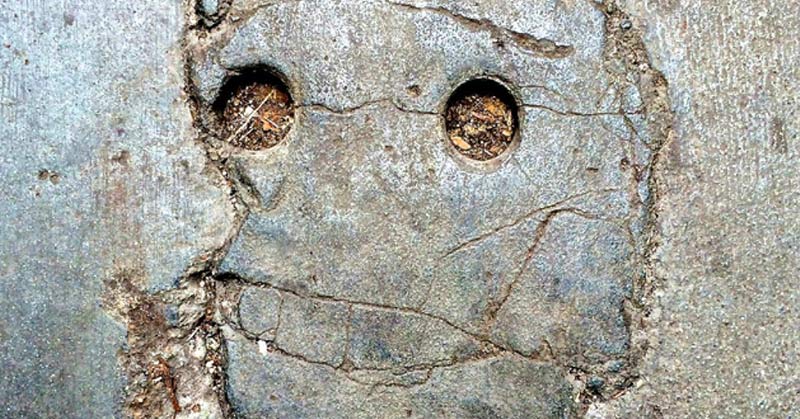Some people tend to see faces in everything, from clouds to bubbling cheese on pizza to raindrops on a foggy window. They may try to point out these findings to others. ‘Hey look, that house looks like it’s smiling!’ But others may not see the smile, or it may take a while until they do.
A new study came out and discovered something fascinating about people who see faces in inanimate objects: they may be neurotic.
The Study of Neuroticism
Researchers in Tokyo at the NNT Communication Science Laboratory gave 166 undergraduate students two kinds of standard psychological tests. One measured their “Big Five” personality traits and the other their emotional mood. Then they showed the students a pattern of random dots in a similar fashion to an inkblot test, and requested they report and draw whatever they saw in the dots. [1]
To clarify, the “Big Five” personality test is an assessment created from previous psychological theories. They are considered to be the building blocks of an individual’s personality. The five traits are a spectrum that ranges from two extremes. For example, individuals are never completely extroverted or introverted; they’re somewhere in the middle.
The traits are:
- Extraversion
People who score high in the extraversion category are outgoing and get energized from social situations. They enjoy meeting new people, have a wide circle of friends, and sometimes speak before thinking. Those who score low are called introverts and they prefer solitude to recharge. They tend to dislike small talk and being the center of attention.
- Agreeableness
Those who are highly agreeable have a great deal of empathy and enjoy contributing to others’ happiness. Those who are low have little interest in the issues of others and may belittle them or manipulate them for their own gain.
- Openness
Those who fall high with this trait tend to be adventurous, creative, and enjoy contemplating abstract concepts. Those who score low dislike change and are not very imaginative.
- Conscientiousness
This trait focuses on thoughtfulness, good impulse control, and ambitions. Those who score high are organized, detail-oriented, and enjoy structure. Those who are low don’t care for schedules and cleaning up messes. They tend to procrastinate important tasks — perhaps never finishing them.
- Neuroticism
Neuroticism, the key word for this study, is a trait about moodiness and emotional instability. Those who are highly neurotic are easily stressed or upset. They may experience dramatic mood shifts and take a long time to recover from a period of anxiety. Those who are less neurotic are emotionally stable and handle stress well. They rarely feel depressed and tend to have a calm, easy-going nature. [2]
The Study Results
The researchers found that the participants who had scored higher on the neurotic spectrum and were feeling negatively on the emotional mood test were very likely to find faces in the dots. They were also likely to see plants and animals.
Moheb Costandi, a neuroscientist turned journalist writing for Brain Decoder, explains that neurotic people are predisposed to pareidolia, a term for the perception of faces in inanimate objects. Because neurotic people tend to be tense and emotionally unstable, their nerves are on high alert for danger, which they may see where there is none. In this case, danger and threat may take the form of a face. This may also be true for those in a negative mood, neurotic or not. [3]
Pareidolia
Pareidolia is fairly common phenomenon, particularly among religious and superstitious individuals, and neurotic people or those who are in sad moods, as the study demonstrated. Women are more likely to experience this because they, on average, have a better ability to recognize emotions through facial expressions than men.
It goes beyond faces though. Broadly speaking, pareidolia causes a person to see patterns in random objects, which may lead them to give them human characteristics. It may also cause a person to hear hidden messages in music or see hidden details in art. [4]
A famous example of pareidolia is seeing the face of a man on the moon, whether through a telescope or through the naked eye.
According to some experts, pareidolia could be the reason people see UFOs, Elvis, or the Loch Ness Monster.
In 2004, a decade old grilled cheese sandwich was sold on eBay for $28,000, because many people saw the image of the Virgin Mary on the toasted bread. [5]
Leonardo d Vinci is a famous example of a person who may have had this perception. In one of his many notebooks, he has written: If you look at any walls spotted with various stains or with a mixture of different kinds of stones… you will be able to see divers combats and figures in quick movement, and strange expressions of faces, and outlandish costumes, and an infinite number of things which you can then reduce into separate and well-conceived forms. [6]
If you are interested in testing whether you see faces in objects, try looking through a few pictures on this Twitter account. If you’re interested in taking the Big 5 Personality Test, click here.
Sources
- Jen Pinkowski. Neurotic People May Be More Likely to See Faces in Objects https://mentalfloss.com/article/66363/neurotic-people-may-be-more-likely-see-faces-objects July 17, 2015
- Kendra Cherry. The Big Five Personality Traits. https://www.verywellmind.com/the-big-five-personality-dimensions-2795422 August 22, 2019
- Melissa Dahl. Neurotic People See Faces in Things https://www.health.com/mind-body/neurotic-people-see-faces-in-things July 21, 2015
- Jiangan Liu. Seeing Jesus in toast: Neural and behavioral correlates of face pareidolia. https://www.sciencedirect.com/science/article/pii/S0010945214000288 April 2014
- Katherine Armstrong. Pareidolia: The science behind seeing faces in everyday objects https://www.lenstore.co.uk/eyecare/pareidolia-science
- September 8, 2017[6] Full text of “Leonardo Da Vinci S Note-Books Arranged And Rendered Into English” https://archive.org/stream/leonardodavincis007918mbp/leonardodavincis007918mbp_djvu.txt

